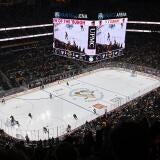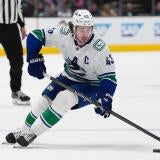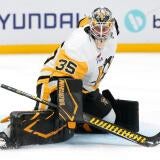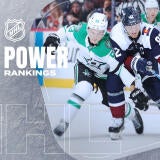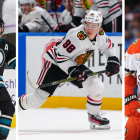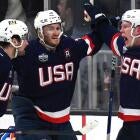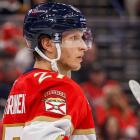NHL Preview: Maple Leafs have their coach, now they need the players
The Toronto Maple Leafs made a huge investment in new head coach Mike Babcock. Now they need to get him some players.

When you're one of the richest teams in the NHL, in a city that obsesses about hockey and is screaming for a winner, and you haven't won a single playoff series in more than a decade, there is going to come a point where sweeping changes are going to be made throughout the organization.
The Toronto Maple Leafs have reached that point over the past couple of years, and this offseason saw some of the most significant changes in quite some time. It's pretty clear there is new leadership in town, and this group might finally have a plan to lead the team back to relevance.
They landed one of the NHL's top coaches in Mike Babcock on a record contract that that is going to pay him $50 million over the next eight years. They followed up by bringing in longtime New Jersey Devils general manager Lou Lamoriello to hold the same position in Toronto. With that, they also made significant changes to the roster that will be taking the ice this fall by trading their top player, Phil Kessel, to the Pittsburgh Penguins after years of trade rumors and speculation. They are also bringing in another round of veterans on short-term contracts in an effort to squeeze every ounce of value out of them that they can.
Slowly but surely the Leafs are starting to stockpile a promising group of young players who could one day be the foundation of something meaningful in Toronto. But that day is probably still a couple of years away, and until they reach that point there are going to be some bumps along the way. Especially this season.
You don't fix 10 years of poor management and bad hockey in one summer with one trade and one coaching change.

2015-16 at a glance
New additions: Michael Grabner, Shawn Matthias, Daniel Winnik, Nick Spaling, P.A. Parenteau, Mark Arcobello, Matt Hunwick, Martin Marincin
Key losses: Phil Kessel, Tim Erixon, Tyler Biggs
Top returning scorers: James van Riemsdyk (82 GP, 27-29--56), Tyler Bozak (82 GP, 23-26--49), Nazem Kadri (73 GP, 18-21--39)
Salary against cap: $71,014,999
Remaining cap space: $385,001
Biggest question heading into 2015-16 season: Who is going to score the goals?
Scoring was already a problem for Toronto, which finished 24th out of 30 teams last season with only 204 goals. And that was with one of the NHL's best scorers -- Kessel -- playing on its top line.
With Kessel now playing in Pittsburgh, the Maple Leafs no longer have an elite scorer on the roster. That is obviously going to leave a big hole offensively, not only because they lost his production, but it's also sure to put a significant dent in the production of Tyler Bozak, one of their top returning scorers from last season, who has managed just 14 career points during 5-on-5 play when he doesn't have Kessel skating on his line (close to 900 minutes).
That is ... not good.
Guys who can score 30 goals every year are an extremely rare asset in today's game, and they're not easy to replace when you get rid of them. And the Maple Leafs did nothing this offseason to immediately fill that void. What they did instead was bring in a number of veterans that are either on one-year "prove it" contracts (P.A. Parenteau, Shawn Matthias, Mark Arcobello, trading for Michael Grabner on the final year of his deal) or tryout deals (Curtis Glencross, Brad Boyes, Devin Setoguchi) as they try to earn a spot in training camp and hold down the fort until the real future of the team (William Nylander, Mitch Marner, Kasperi Kapanen) is ready to take over.
In the short term, it's going to have to be an "offense by committee" approach. How it works out remains to be seen and will go a long way toward determing how good or bad the 2015-16 version of the Maple Leafs turns out to be.
Season outlook: The interesting thing about this Maple Leafs roster is that even though they're entering what is very obviously a rebuilding phase, you wouldn't really know it by looking at their roster, especially when it comes to their forwards.
They're not going to rush their top prospects (Kapanen, Marner, Nylander, etc.) to the NHL level until they're absolutely ready to be full-time contributors, while the majority of their forwards on the roster for this season are over the age of 26. That means they are at a point in their careers where they are probably already as good as they're ever going to be.
That leads to a pretty wide range of potential outcomes for the season.
Even though they're lacking a true go-to guy offensively (James van Riemsdyk is probably the closest thing they have at this point), they don't really have any glaring holes at forward, either. They don't really have anybody that is a complete zero offensively and a lot of the veterans can at least hold their own in the NHL. It's not a particularly great roster, but it's not 2014-15 Buffalo Sabres bad, either.
If this team does have a strength and a hope for success this season it's probably going to come from their goaltending duo of James Reimer and Jonathan Bernier. And even though Dion Phaneuf's contract is turning into an albatross and one they would probably prefer to move sooner rather than later, they do have a couple of intriguing players on their defense in Jake Gardiner and Morgan Rielly, two of the young players who are going to get an opportunity to play significant roles on this year's club. They've already shown flashes of being quality top-four defensemen in the NHL and could be a real bright spot this season.
It's probably not going to be a team that has the playoffs in its future this season, but if they can catch lightning in a bottle with some of the veteran forwards on one-year deals and get quality goaltending they might be able to at least hang around in the playoff race a little longer than you might expect.
If nothing else, the Leafs should have plenty of options to deal at the trade deadline for more future assets given the number of veterans they have on one-year and expiring contracts. They had a lot of success in 2014-15 with a similar strategy and were able to flip guys like Winnik, Mike Santorelli and Cody Franson for a number of future draft picks. They should, in theory, be able to do it again this season. Not all of the picks will pan out in the long run, but the best way to find future NHL players in the draft if you're not picking at the top is to give yourself as many opportunities as possible in the draft. And the Maple Leafs have been doing exactly that over the past couple of years.


